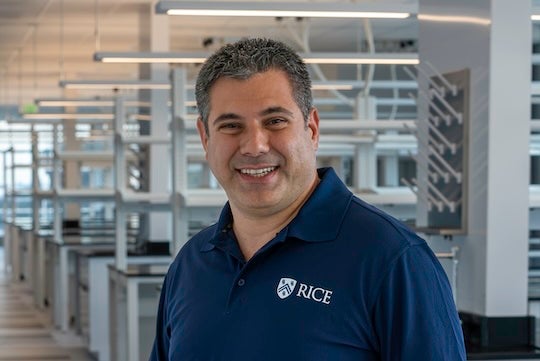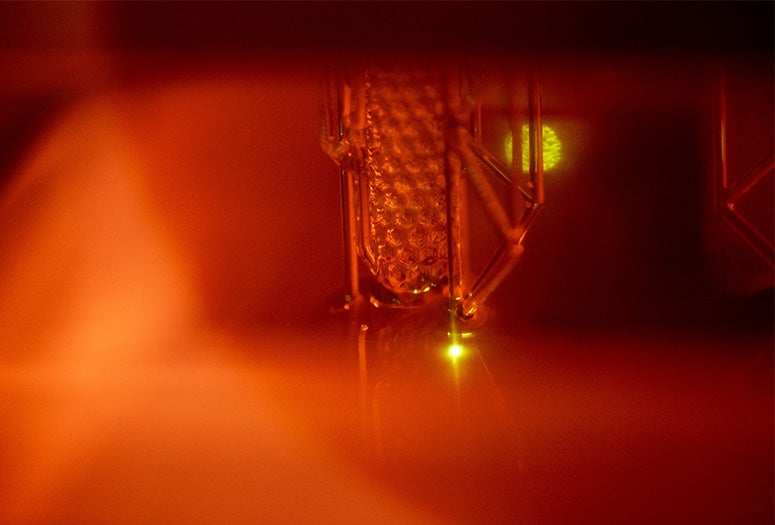Rice University is part of a multiuniversity research team that has secured an award of up to $34.9 million from the Advanced Research Projects Agency for Health (ARPA-H) to accelerate the development of a bioelectronic implant designed to improve adherence for obesity and Type 2 diabetes (T2D) treatment while reducing development and manufacturing costs.

Rice University’s Biotech Launch Pad will lead the commercialization effort for “Rx On-site Generation Using Electronics” (ROGUE), a self-contained, durable implantable device that houses cells engineered to produce T2D and obesity therapies in response to patients’ physiological needs.
Carnegie Mellon University leads the team of researchers driving the accelerated development and testing of ROGUE, which functions as a “living pharmacy” designed to make biologic drugs, or biologics (a rapidly expanding group of therapies derived from living cells), accessible in the body on demand. With a target cost of goods below $1,000 for at least one year of therapy, ROGUE aims to significantly lower the costs of biologics-based treatments.
ROGUE uses closed-loop bioelectronics to support, monitor and adjust drug production and dosing as well as communicate with patients. The implant will be recharged using a wearable device weekly or even less frequently, eliminating the need for managing daily, weekly or monthly medication administering, storage and restocking. This technology is designed for rapid and cost-effective deployment via a minimally invasive procedure in an outpatient clinic.
“ROGUE’s innovative design combines efficient biological manufacturing, long-term durability and patient-friendly features that have the potential to transform the landscape of biologics delivery,” said Omid Veiseh, professor of bioengineering and faculty director of the Rice Biotech Launch Pad. “With the Rice Biotech Launch Pad leading the clinical translation and commercialization efforts, this funding will allow us to expedite the development and clinical trials of this groundbreaking technology, making it accessible to patients sooner.”
In-house entrepreneur and executive director of the Rice accelerator, Paul Wotton, will be involved in every step of the process to ensure the evolution of this technology from research to clinical translation to an independent company.
“With the Biotech Launch Pad, our goal is venture creation in parallel to the groundbreaking research at Rice and its collaborating institutions,” Wotton said.
Including backing for ROGUE, the team of researchers developing the project has received over $100 million through cooperative agreements from ARPA-H and the Defense Advanced Research Projects Agency (DARPA) for two other “living pharmacy” projects — THOR and NTRAIN.
“This level of support speaks volumes to just how transformative these innovations could be, and therefore how important it is to facilitate their translation,” Wotton said.
“I am absolutely thrilled by ARPA-H’s strong support for the Rice Biotech Launchpad’s efforts in accelerating breakthrough bioelectronic technology transition from the bench to the bedside,” said Paul Cherukuri, Rice’s vice president for innovation and chief innovation officer.
Carnegie Mellon materials science and bioengineer Tzahi Cohen-Karni said that ROGUE’s bioelectronic integration represents a revolutionary advancement in biologics production.
“Our approach enables on-demand production of therapeutics in a highly energy-efficient manner,” said Cohen-Karni, who serves as primary investigator on the ARPA-H award. “This technology not only simplifies the delivery of lifesaving medications but also enhances patient comfort and adherence. ROGUE’s precision and adaptability offer a much-needed improvement in both treatment efficacy and patient experience.”

Jonathan Rivnay, a professor of biomedical engineering at Northwestern University, said that biologics, including antibodies, hormones, growth factors and cytokines, are expensive and account for a significant portion of health care expenses.
“ROGUE’s ability to produce glucagon-like peptide 1 receptor agonist (GLP-1 RA) on site will address these high costs and improve patient adherence by eliminating the need for frequent injections,” Rivnay said. “GLP-1 RAs have proven effective in enhancing insulin secretion, reducing glucose levels and promoting significant weight loss, making them a first-line therapy for diabetes and obesity.
“Our collaborative efforts are paving the way for the ROGUE platform to become a revolutionary force in the field of biologics. This technology not only addresses the limitations of current biologics but also offers a sustainable, long-term solution for managing chronic diseases.”
GLP-1 RAs are a leading class of drugs for treating patients with T2D and obesity. Unlike other T2D therapies, GLP-1 RA-based drugs are also effective against obesity. Despite their efficacy, GLP-1 RAs are expensive and often inaccessible to many patients. ROGUE’s sustainable, on-demand production system will mitigate these challenges by providing a cost-effective, widely available solution, according to the research team. The ROGUE device is expected to offer the same benefits as traditional GLP-1 RAs, including the prevention of cardiovascular and kidney disease progression in high-risk patients.

This pioneering project was rigorously assessed as a potential project for ARPA-H, a federal funding agency established in 2022 to support research that has “the potential to transform entire areas of medicine and health.” This effort is funded under ARPA-H’s REACT program and includes funding for a first-in-human clinical trial for patients facing obesity and T2D. The trial preparation is slated to begin in the fifth year of the six-year project.
Other Rice co-principal investigators include Jacob Robinson, a professor of electrical and computer engineering and bioengineering who leads integration efforts for the project in line with the focus on clinical translation and commercialization; and Oleg Igoshin, a professor of bioengineering and chemistry and associate chair of the bioengineering department who oversees pharmacokinetics and pharmacodynamics modeling.
ROGUE is a collaboration between multiple institutions, including Rice, Carnegie Mellon, Northwestern, Boston University, Georgia Institute of Technology, University of California Berkeley, the Mayo Clinic and New York City-based Bruder Consulting and Venture Group. The consortium brings together experts in biomedical engineering, synthetic biology, materials science, electrical engineering and related fields to co-design and develop the implant technology.
- Download associated media assets:
- About the Rice Biotech Launch Pad:
-
The Rice Biotech Launch Pad is a Houston-based accelerator focused on expediting the translation of Rice University’s health and medical technology discoveries into cures. This initiative is designed to help advance internally discovered platform technologies from concept to clinical studies and commercialization. The Rice Biotech Launch Pad will identify and support highly differentiated projects while driving the expansion of Houston as a world-class medical innovation ecosystem. The accelerator will bring together local researchers with a network of industry executives. For more information, please visit https://biotechlaunchpad.rice.edu/.
- About Rice University:
-
Located on a 300-acre forested campus in Houston, Rice University is consistently ranked among the nation’s top 20 universities by U.S. News & World Report. Rice has highly respected schools of architecture, business, continuing studies, engineering, humanities, music, natural sciences and social sciences and is home to the Baker Institute for Public Policy. With 4,574 undergraduates and 3,982 graduate students, Rice’s undergraduate student-to-faculty ratio is just under 6-to-1. Its residential college system builds close-knit communities and lifelong friendships, just one reason why Rice is ranked No. 1 for lots of race/class interaction, No. 2 for best-run colleges and No. 12 for quality of life by the Princeton Review. Rice is also rated as a best value among private universities by Kiplinger’s Personal Finance.

